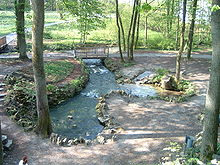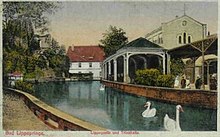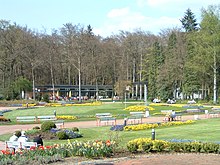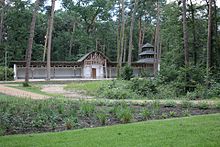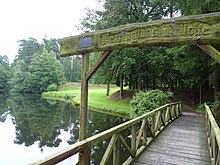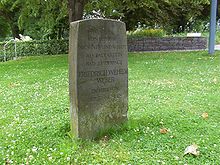Bad Lippspringe
| coat of arms | Germany map | |
|---|---|---|
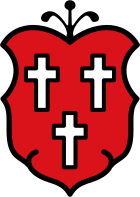
|
Coordinates: 51 ° 47 ' N , 8 ° 49' E |
|
| Basic data | ||
| State : | North Rhine-Westphalia | |
| Administrative region : | Detmold | |
| Circle : | Paderborn | |
| Height : | 140 m above sea level NHN | |
| Area : | 51.01 km 2 | |
| Residents: | 16,237 (Dec. 31, 2019) | |
| Population density : | 318 inhabitants per km 2 | |
| Postal code : | 33175 | |
| Area code : | 05252 | |
| License plate : | PB, BÜR | |
| Community key : | 05 7 74 008 | |
| LOCODE : | DE WARC | |
City administration address : |
Friedrich-Wilh.-Weber-Platz 1 33175 Bad Lippspringe |
|
| Website : | ||
| Mayor : | Andreas Bee (independent) | |
| Location of the city of Bad Lippspringe in the Paderborn district | ||
The climatic health resort Bad Lippspringe is a district town in the northeast of the German state of North Rhine-Westphalia and is located on the edge of the Teutoburg Forest in the Teutoburg Forest / Eggegebirge Nature Park . The East Westphalian spa with around 16,000 inhabitants belongs to the Paderborn district and is located about eight kilometers northeast of Paderborn . The Lippspringe, which originated at the Lippe spring from which it is named , was first mentioned in 780. In 2017, the city hosted the North Rhine-Westphalia State Horticultural Show . The state horticultural show in Bad Lippspringe was the first state horticultural show in front of a forest backdrop.
geography
Geographical location
Bad Lippspringe is located on the edge of the Teutoburg Forest in the Teutoburg Forest / Eggegebirge Nature Park and is a medicinal bath and climatic health resort. The karst springs of Lippe and Jordan are located in Bad Lippspringe , but they still flow into the Lippe in the urban area. There are also four healing springs (Martinus Spring, Alte Arminius Spring, New Arminius Spring and Liborius Spring) that are open to the public. Large parts of the nature reserve and Senne military training area north of Bad Lippspringe are part of the urban area.
The lowest point of the urban area is at 140 m, the highest at 334 m.
geology
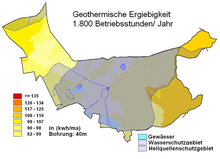
The subsurface near the surface in the Bad Lippspringe area consists mainly of marl limestones from the Upper Cretaceous, which are not very tectonically disturbed . These are slightly inclined towards the interior of the Münsterland Basin , on the eastern edge of which the urban area is located. As the slope increases, these rocks are covered by the slightly younger clay marl stones of the so-called Emscher marl. Both rocks lie on a plinth of folded Devonian and Carboniferous rocks .
In the north-western flatland area belonging to the Senne military training area, the blanket mostly consists of sandy, loose rock from the Ice Age . It comes from sediments of the Lippe , Beke and Strothe and also ground moraine and meltwater sands .
The groundwater structure in the urban area is richly diversified. The top floor, used for individual supplies, is made up of meltwater sands from the Ice Age and river sands and gravel from the Lippe and Strothe. The next lower layer is a well-drained karst aquifer . The karst groundwater flowing in from the southeast reappears in the Lippe, Jordan , Beispring and Thune springs. However, it is at risk of pollution as a result of feeding from surface water and high underground flow velocities. The municipal waterworks pumped drinking water from the open karst on the market square until 1978, after which it was connected to the Paderborn waterworks due to hygienic problems.
The deepest groundwater storey consists of marl and sandstones from the Lower Cretaceous and contains highly mineralized sulphate water . It occurs in several sources (Arminiusquelle, Liborius source Martinus source, the latter with 27.8 ° C, the warmest of bad lippspringe mineral springs) to light and in the context of health cures balneologically used as medicinal waters, in the case of about 20 ° C warm Arminius spring since 1832.
In the urban area are sandy and isolated also gravel of Quaternary for use as bulk materials and construction sand and also for the production of calcium silicate blocks removed. Quaternary clay and silt were also used as raw materials for brick production.
In the western lowlands, acidic, nutrient-poor Podsol has formed over a large area, which is partially interspersed with stone in the subsoil . Soil development only begins on the dune sands, which are a few hundred years old , so regosols that are sensitive to drought and poor in nutrients appear. Gley , which are natural grassland locations, predominate in the valleys . Pseudogleye developed on the bed load clay of the ground moraine. In the east of the urban area, i.e. on the Egge and the Paderborn plateau , the marl limestones of the Upper Cretaceous have weathered to form brown earth . Medieval clearing meant that the loess , which was once widespread here, was washed away into the valleys and formed into colluvia there .
Bad Lippspringe is suitable in the populated areas to a limited extent for the use of geothermal heat sources by means of geothermal probes and for heat generation through heat pump heating . Isolated locations are not suitable (see the adjacent map).
Expansion and use of the municipal area
The community, classified as a "large rural community", covers an area of 50.99 km². The largest share of the area is forest and agricultural areas with a total of approx. 72.6%, settlement and traffic areas cover a further 15.6%. Bad Lippspringe has a significant proportion of heathland (around 10.77%). The largest extension in north-south direction is approx. 10.6 km, in east-west direction approx. 14.2 km.
| Area according to type of use |
Agricultural area |
Forest area |
Building, open and operational space |
Traffic area |
Surface of water |
Sports and green space |
other use |
|---|---|---|---|---|---|---|---|
| Area in km² | 17.31 | 19.72 | 3.60 | 2.88 | 0.50 | 1.45 | 5.51 |
| Share of total area | 33.95% | 38.68% | 7.06% | 5.65% | 0.98% | 2.84% | 10.81% |
Neighboring communities
In the north, Bad Lippspringe borders on the community of Schlangen, which belongs to the Lippe district . To the east lies the municipality of Altenbeken , in the southwest the district town of Paderborn and to the west the municipality of Hövelhof . The three places belong to the Paderborn district .
City structure
Neither the main statute nor the population of Bad Lippspringe differentiates between districts and localities.
climate
Bad Lippspringe belongs to the moderate climate zone of Central Europe and lies in the area of the subatlantic maritime climate . The winters are mostly mild under the influence of the Atlantic and the summers are moderately warm. The annual mean temperature is around 8.5–9 ° C.
Due to the location in the sub-Atlantic maritime climate, a humid climate prevails all year round with relatively evenly distributed rainfall. A total of 867 mm of precipitation falls annually at the Schieder measuring station .
|
Climate Bad Lippspringe (157 m)
Source: German Weather Service
|
||||||||||||||||||||||||||||||||||||||||||||||||||||||||||||||||||||||||||||||||||||||||||
For the climate in the Ostwestfalen-Lippe region , to which the city belongs, see also the article Climate in Ostwestfalen-Lippe .
history
| Capitals and cities of the Principality of Paderborn until 1802/03 (as of 1789): |
|---|
| Paderborn , Warburg , Brakel , Borgentreich | Beverungen , Borgholz , Bredenborn , Büren , Driburg , Dringenberg , Gehrden , Calenberg , Kleinenberg , Lichtenau , Lippspringe , Lügde , Nieheim , Peckelsheim , Salzkotten , Steinheim , Vörden , Willebadessen , Wünnenberg |
Bad Lippspringe has belonged to the secular rule of the German diocese Paderborn , originally in the duchy of Saxony , since it was founded . From the 14th century the territory of the prince-bishopric of Paderborn ( Hochstift ) was formed in the Holy Roman Empire , and from the 16th century it was part of the Lower Rhine-Westphalian Empire . In 1802/03 the bishopric was occupied by the Kingdom of Prussia. In Napoleonic times the place was on the territory of the Kingdom of Westphalia . Bad Lippspringe has belonged to the Kingdom of Prussia since 1815 . 1945 to 1949 it was part of the British zone of occupation , since 1946 of the state of North Rhine-Westphalia .
The place was first mentioned in 780. Charlemagne calls it "Lippiogyspringiae" and held three imperial assemblies here in 776, 780 and 782 during the Saxon-Franconian War (772 to 804). At the Imperial Assembly of 782 , among other things, the Franconian county constitution was introduced in Saxony.
In 1235 the "von Lippspringe" family was first mentioned. In 1312 the Paderborn built Domkapitel the castle Lippspringe on the lip source. In the vicinity of the castle, farmers and craftsmen from the area settled. In 1445, the cathedral chapter elevated the now fortified Lippspringe settlement to a town. After numerous feuds and the resulting damage, the castle was renovated and re-fortified in 1482, as well as in 1665 after severe destruction in the Thirty Years War (1618 to 1648). During the Seven Years' War (1756 to 1763) the castle was badly damaged again, so that in 1785 the last inhabited building of the castle had to be abandoned. Today it is only a ruin.
In 1801, in the Treaty of Lunéville , France received the German territories on the left bank of the Rhine. Prussia was for its possessions there a. a. compensated with the duchy of Paderborn. The cathedral chapter also lost its property in Lippspringe, which initially came under the Prussian domain administration and was later sold to private individuals.
In 1832 the Arminius Spring was discovered by chance as the first healing spring . Until then, it was mistakenly considered a secondary source of the lip .
Like all Prussian towns with fewer than 2,500 inhabitants, Lippspringe lost its town charter in 1843 .
In 1913 the place was officially named "Bad Lippspringe" and in 1921 it regained city rights. In 1962 the Martinus spring was drilled in the Kurwald. Today it supplies the thermal outdoor pool, the Westfalen-Therme , the indoor pool, the therapy center Martinus-Quelle with the exercise pool and the drinking hall in the Kaiser-Karls-Park. According to the new health resort law of the state of North Rhine-Westphalia , Bad Lippspringe became a "state-approved spa" in 1975. In 1980 the place was recognized as a " climatic health resort ".
As part of the Expo Initiative Ostwestfalen-Lippe , the allergy trail and communication park were built in 2000. In addition, the fog meadow on the Jordan was created to create an area with reduced pollen count for allergy sufferers.
In December 1923 the Mechanische Weberei GmbH was founded here, which in 1957 was "Europe's largest special factory for projection screens". For the first time, woven canvas was coated with glass beads (23 million / m 2 ). Production was relocated to Červený Kostelec , Bohemia, Czech Republic in 1991/1992 , where the mechanical weaving mill Bohemia sro produces again under the “MW” brand.
Religions
Due to its affiliation to the former Paderborn Monastery, the population in Bad Lippspringe is traditionally predominantly Catholic .
A Protestant parish assigned to Paderborn was founded in Bad Lippspringe in 1838 and a first presbytery was elected. With donations and 3,100 Reichstalers from the state treasury, a school and a church, consecrated on July 17, 1846, were built and a church tower was added in 1859. From 1850 there were auxiliary preachers in the city, in 1864 the first parish priest was introduced. In the same year, the church had to be expanded due to the growth of the community, and again in 1900 due to the increasing spa business.
In addition, there is the Christian community in Bad Lippspringe , a free -church , Protestant-Reformed community.
The denominational affiliation of the students in Bad Lippspringe can be an indication of the distribution of religions. Accordingly, in the 2006/2007 school year, 29.7% of the students stated Protestant, 43.7% Catholic and 12% Islamic as their religious affiliation. 6.9% said they belonged to another religion and 7.7% had no denomination.
Incorporations
In 1885 a small part (1871: 14 inhabitants) of the community of Neuenbeken was incorporated into the city of Bad Lippspringe.
As part of the North Rhine-Westphalian regional reform , in the course of the implementation of the "Law for the reorganization of the municipalities and districts of the reorganization area Sauerland / Paderborn ( Sauerland / Paderborn law )" from November 5, 1974 to January 1, 1975, an exchange of territory between the city of Bad Lippspringe and the community of Schlangen, which also affected inhabited areas.
Population development
The following overview shows the population of the city of Bad Lippspringe according to the respective territorial status, which remained almost unchanged over the entire period. The figures are census results from 1818 to 1970 and 1987, and from 1975 official updates from the State Office for Data Processing and Statistics . The figures from 1975 to 1985 are estimated values, the figures from 1990 are extrapolations based on the results of the 1987 census. From 1871 and 1946, the figures relate to the local population , from 1925 to the resident population and from 1985 to the population at Location of the main residence . Before 1871, the population figures were determined using inconsistent survey methods.
|
|
|
politics
City council
The city council has 42 seats since the 2014 local elections. In addition, the mayor is the council chairman.
The following table shows the local election results since 1975:
| 2014 | 2009 | 2004 | 1999 | 1994 | 1989 | 1984 | 1979 | 1975 | ||||||||||
|---|---|---|---|---|---|---|---|---|---|---|---|---|---|---|---|---|---|---|
| Political party | Seats | % | Seats | % | Seats | % | Seats | % | Seats | % | Seats | % | Seats | % | Seats | % | Seats | % |
| CDU | 16 | 38.23 | 11 | 31.11 | 17th | 51.25 | 16 | 50.27 | 18th | 52.66 | 18th | 52.52 | 16 | 47.49 | 19th | 56.42 | 20th | 59.17 |
| FWG 1 | 10 | 22.82 | 10 | 26.73 | - | - | - | - | - | - | - | - | - | - | - | - | - | - |
| SPD | 7th | 17.59 | 7th | 18.18 | 6th | 20.86 | 8th | 26.62 | 11 | 35.05 | 11 | 34.82 | 11 | 34.72 | 10 | 31.36 | 10 | 32.38 |
| Green | 4th | 8.68 | 4th | 10.16 | 4th | 12.28 | 4th | 11.10 | - | - | - | - | - | - | - | - | - | - |
| FDP | 3 | 6.76 | 3 | 9.62 | 5 | 15.62 | 4th | 12.01 | 4th | 12.29 | 4th | 12.66 | 6th | 17.80 | 4th | 12.22 | 3 | 8.45 |
| left | 2 | 5.91 | 1 | 4.18 | - | - | - | - | - | - | - | - | - | - | - | - | - | - |
| Total 2 | 42 | 100 | 36 | 100 | 32 | 100 | 32 | 100 | 33 | 100 | 33 | 100 | 33 | 100 | 33 | 100 | 33 | 100 |
| voter turnout | 47.81% | 56.20% | 54.58% | 61.63% | 81.09% | 66.87% | 69.44% | 74.56% | 89.37% | |||||||||
1 Free voter community Bad Lippspringe
2 without taking into account rounding differences
- Result of the local election on May 25, 2014
|
Election of the Bad Lippspring City Council in 2014
Turnout: 47.8% (2009: 56.2%)
% 40 30th 20th 10
0
38.2%
22.8%
17.6%
8.7%
6.8%
5.9%
Gains and losses
|
mayor
- 1971 to 1984: Josef Antpöhler (* July 16, 1927; † November 19, 2008)
- 1984 to 1992: Elisabeth Winkler
- 1992 to 1999 Martin Schulte (CDU)
- 1999 to 2009: Willi Schmidt
- 2009 until today: Andreas Bee
In the mayor election on August 30, 2009, Schmidt did not stand again and the non-party individual applicant Andreas Bee was elected the new mayor with 67.74% and took office on October 21, 2009. In September 2015, Andreas Bee was re-elected mayor.
The mayor relies on a council majority made up of CDU and FWG.
badges and flags
- Blazon : The coat of arms of the city of Bad Lippspringe shows three silver (white) crosses in the red field.
- Flag : The flag of the city of Bad Lippspringe shows the colors red and white striped lengthways and is provided with the city's coat of arms.
The community was granted city rights around 1445. Nevertheless, a coat of arms is only known in 1623. This already showed three crosses, which presumably came from the coat of arms of Paderborn. In the 18th century the colors changed to today's. The current coat of arms was approved when the city was recognized as a bath.
Town twinning
The friendship between Bad Lippspringe and Templin in Brandenburg existed even before the reunification of Germany . On September 1, 1990, the city friendship certificate was signed.
Since the international town twinning with Droichead Nua ( Newbridge ) in County Kildare , Ireland , in 1997, more than 2500 people from the two towns have visited each other. The partnership associations ensure a lively exchange and maintenance of the partnership.
Culture and sights
Theater and cinema
The city does not have its own theater. The city-sponsored congress center can be used for cultural events for up to 620 people. The closest playhouses are the Bielefeld Theater , the Detmold State Theater and the Paderborn Theater , in whose catchment area Bad Lippspringe is located. Since June 2003 the Lippe Institute - opposite the Lippequelle - has been home to the Odins Film Theater. The program consists of current feature films.
Museums
The local heritage association operates a local history museum in the Hartmann house in Bad Lippspringe . Here primarily exhibits on local history and local agriculture are shown. The museum is divided into five epochs. A model of Bad Lippspring's town hall from 1802 and a city model from 1600 are considered worth seeing.
music
In the field of choral music there are offers for different target groups. The gentlemen's vocalists sing pieces by the Comedian Harmonists, folk songs and romantic choral pieces. In the children's and youth choir fountain sing and play boys and girls aged 3 to 27 years. The Harmonie men's choir was founded in 1919 and consists of around 80 singers whose repertoire includes folk songs and modern choral compositions. The pastoral association Bad Lippspringe und Schlangen offers a children's choir, its own music group, the Schola Cantorum Lippiagyspringiae and the St. Martin children's choir
The choir of the Ev. Church with its 70-80 singers the mainstay of ev. Church music in Bad Lippspringe. Great well-known oratorios by J. S. Bach such as his passion music and every year Bach's well-known Christmas oratorio are rehearsed and performed in addition to the chanting in worship.
The Kolping Musikverein has around 60 musicians and plays marches and modern light music . The music train of the volunteer fire brigade trains young people and adults on instruments. They play at festivals and their own concerts. The marching band of the volunteer fire brigade consists of 40 musicians.
Buildings
Gut Dedinghausen is located at Dedinghauser Weg 10 . This was first mentioned in 1036. Some buildings date from the beginning of the 17th to the 19th century. Two decorated chimney cheeks were built in the manor house around 1600.
The mighty residential building of Lippspringe Castle (ruin) at the Lippequellen probably dates from the 13th or 14th century. In 1785 the already dilapidated castle was finally given up.
In 1696 there was a wayside shrine with a Pietà in Bad Lippspringe . Later the linden chapel was built around the holy house, the back wall of which was formed by the wayside shrine.
The Catholic Marienkapelle is a three-bay hall building from 1842.
The Protestant parish church was built on Detmolder Strasse from 1845 to 1846 . The tower dates from 1859, the side aisles were not added until 1899–1900. In 2005 the church was renovated and the interior redesigned.
The Catholic parish church of St. Martin is a neo-Gothic hall church and was built in 1899/1900. The west tower, which is essentially Romanesque, is provided with a Renaissance portal, above which there is a relief of Martin from 1600. The historical furnishings are almost completely preserved.
The so-called Prinzenpalais in Arminiuspark is a villa-like classicist spa house from 1853 to 1854.
The listed well house of the Liborius mineral spring is also worth seeing
In the south and west of the city center, in the area of the street An der Stadtmauer , longer sections of the city wall built around 1380 have been preserved, some of which are built into houses. The wall was about 6 meters high and was largely removed around 1800. In the southeast of the fortification there is the stump of a round wall tower , which can be seen from Steinbekestraße. In the northeast corner there was a tower about 10 meters high, the foundation walls of which were exposed between 2006 and 2008 and then rebuilt.
The Brother Klaus Peace Chapel , consecrated to St. Niklaus von Flüe , is located in the Kurwald .
Parks, forest and garden show

There are four designated parks in Bad Lippspringe. These are the Arminius and Jordan parks, which are directly adjacent to each other and only separated by a street. They are open to the public and have a total size of around 6.5 hectares . Both green areas enjoy great public popularity and serve as a meeting point. The Jordan Park is home to the eponymous Jordan spring and has a more forest-like character. There is also a water playground for children here. The Arminiuspark, located south of Jordanpark, has a large lawn and has more of a park character. Part of the North Rhine-Westphalia State Horticultural Show will also take place here in 2017 . Due to the work required for this, the paths at and in Arminiuspark will be temporarily closed in isolated cases until then. The Arminiuspark was created in the 1840s and was designed by the Paderborn art gardener Nölting in the style of an English landscape garden. He used plans by the famous horticultural director Peter Joseph Lenné and his students as a model. The park is in the immediate vicinity of the Lippe spring and the town's castle ruins. The former Kurhaus, now known as the Prince's Palace, is also located here . The so-called Nebelwiese can also be found in Arminius Park . Towering tubes occasionally distribute artificially generated fog. This is intended to demonstrate to visitors the reduction in pollen counts in damp weather.
The Kaiser-Karls-Park , a spa park with water fountains, many flower beds and rare trees, was laid out from 1951, as Arminius and Jordan parks had been confiscated by the British armed forces as a result of the war. The park was named after Charlemagne , who already stayed in "Lippiogyspringiae in Saxonia". The facility was open to the public and was around four hectares in size. With flower beds, ornamental shrubs and evergreen trees, the park was laid out as a pleasure garden in contrast to the Arminius Park and initiated a new beginning of the spa business. In the course of the construction work for the State Garden Show 2017, the park was closed and is currently being prepared for the Garden Show. In combination with the adjacent spa forest, a realignment of the planting concept is being implemented.
The spa forest mentioned above borders the urban area to the north and is about 200 hectares in size. It was created at the beginning of the 19th century to stop the moving dune approaching from the Senne . For this, more pines were planted and the dunes were reshaped and strengthened. In this mixed pine forest, a pleasant forest climate developed, which was later used at the wedding of the spa to allow the patients to linger in so-called reclining halls. A copy of these historical lounge halls still exists today. This forest backdrop will also be part of the state horticultural show in 2017. The forest is currently partially closed for work. The network of paths is being renewed, clearings have been made in the forest and play stations for children, which will remain after the garden show, have been built.
Another park in the urban area with approx. Nine hectares is located directly at the Auguste-Victoria-Stift . This clinic park is also open to the public.
Planet path
In Arminius Park near the Prinzenpalais, a 6 km long planetary path begins with the model of the sun on a scale of 1: 1 billion. Both the distances and the sizes of the celestial body models are shown on this scale. The educational trail was sponsored by the Ostwestfalen-Lippe Planetarium Society . It is one of the most beautiful and varied planetary trails in Germany.
Protection designations for nature
Three nature reserves extend over the urban area. The largest of these is the Egge-Nord area, which with its extension covers around 765 hectares. Other protected areas are the Rosenberg with around 26.8 ha and the lip lowland, which extends to around 159.3 ha as far as the Mastbruch district of Paderborn .
In Bad Lippspringe, the Beispring spring is designated as the youngest natural monument. Other monuments are a field maple on Kurparkstrasse, a plane tree in Arminius Park, the "Hermann Löns Oak" on the northeastern edge of the Kurwald and a summer linden tree each on Burgstrasse and Dammhof.
In the urban area in 1989 and 1999 with the landscape plans Paderborn - Bad Lippspringe and Sennelandschaft, in addition to the already listed protection designations, the landscape protection areas landscape protection area flowing waters and floodplains , landscape protection area Paderborn and Bad Lippspringer forests , landscape protection area open cultural landscape (Paderborn - Bad Lippspringe with Bad Lippspringe) , landscape protection area Kurwald Strotheaue and the Untere Senne landscape protection area designated by the district council .
Sports
The two general sports clubs in town are BV Bad Lippspringe and TV Jahn . Other sports clubs offer darts , golf , gymnastics , chess , shooting sports , tennis , table tennis and volleyball . In Bad Lippspringe there is also a DLRG local group, a swimming club, a riding and driving club as well as an automobile club and a dance club .
In Stadium on Kurwald there is an artificial pitch and a grass court. The BVL football matches take place here. Furthermore, the athletic disciplines for the sports badge are accepted here. An artificial turf pitch is available to clubs and the public at the school in Bruch. The city has had a bike course since 2007, which was set up especially for BMX bikes. There are three routes of different difficulty levels on over 2500 m².
Regular events
On the last weekend in July, Bad Lippspringe celebrates the European Festival with an inner city fair . Every year one EU country is selected as the host country and focus.
The city festival takes place annually on the second weekend in October. A fair is also held here. The parks in the city center are also illuminated.
Culinary specialties
The waters of the Liborius, Arminius and Martinus springs are considered medicinal waters and can be freely extracted. Medicinal water is also served in the Kaiser-Karls-Trinkhalle.
Economy and Infrastructure
traffic
The federal highway 1 affected the city Bad Lippspringe in North-West. The K38, which connects Marienloh with Schlangen runs through the village . The A 33 can be reached with the B 1 via the Paderborn-Elsen junction.
The closest train stations are the long-distance train stations Paderborn Hbf (approx. 10 km away) and Altenbeken (approx. 14 km away) and the regional train station Horn-Bad Meinberg on the Herford – Himmighausen railway line (approx. 16 km away). Between 1906 and 1965 the town had railway line Paderborn North Bad Lippspringe a parallel connection of Paderborn. The tracks have now been completely dismantled and some of them have been rededicated as a cycle path.
Bad Lippspringe can be reached with regional buses on the R50 Paderborn – Schlangen and the R51 Horn - Bad Lippspringe - Paderborn buses. There is a 15-minute cycle to Paderborn on weekdays, every half an hour on Saturdays and every hour on Sundays, except during off-peak times. In addition, during the lecture times of the University of Paderborn, the university line runs between Schlangen and the university. The city belongs to the local transport network Paderborn-Höxter ("Hochstift tariff").
The nearest commercial airport is Paderborn-Lippstadt Airport, around 30 km away . For general aviation is the airport Paderborn-Haxterberg used, which is located approx 15 km southwest of Bad-Lippspringe.
The Bad Lippspringe airfield , which is part of the Senne military training area, borders directly on the city . It is currently used by the Rhine Army Parachute Association for skydiving operations, which also offers jumps for private individuals.
media
In Bad Lippspringe, two daily newspapers appear with the Neue Westfälische and the Westfälischer Volksblatt . In addition, the journal Die Warte for the districts of Paderborn and Höxter appears quarterly in the Hochstift Paderborn , with articles on regional history, literature and art. In addition, the Bad Lippspringer Nachrichten and the Quelle newspaper are two city magazines financed by advertisements.
Bad Lippspringe belongs to the reporting area of the regional studio Bielefeld of the WDR and Radio Hochstift , which it covers in the reporting as local radio.
Public facilities
The Westfalen-Therme offers various water and adventure worlds on 18,000 m². There is also a sauna area and several outdoor swimming pools. The thermal bath is supplied by the Martinus spring, which was drilled in 1962.
Both the Evangelical Church and the Catholic Churches of St. Marien and St. Martin operate a public library.
The Bad Lippspringe volunteer fire brigade is divided into seven departments, including three fire engines , a youth fire department , the honorary department as well as the minstrel and music train. Is equipped with a fire brigade command vehicle , two erase pool vehicles , a turntable ladder , a pumper and a rescue vehicle as well as three side transport vehicles and a command car .
education
The community offers two primary schools and one comprehensive school. In 2007, a total of 1492 pupils were taught at the municipal schools with 91 teachers, 40.6% of them at the primary schools, 13.3% at the Hauptschule, 42.4% at the Realschule, and 3.7% at the special school . The 4-class comprehensive school Bad Lippspringe-Schlangen was founded for the 2013/14 school year.
There is a branch for adult education at the adult education center in Paderborn . The Medical Center Bad Lippspringe GmbH operates the Lippe Institute , consisting of a specialist school for speech therapy , a specialist school for physiotherapy and the Cecilienschule , a school specifically for the sick.
The W&W Music School is a member of the Federal Association of German Private Music Schools . It offers early musical education, learning to play instruments as well as music theory and singing and ear training.
Established businesses
The city's main occupation is the health sector. Seven clinics with different focuses have merged to form the Medical Center for Health (MZG) . The Waldfrieden private clinic mainly offers offers for senior citizens.
Otherwise Bad Lippspringe is characterized by medium-sized companies with a balanced mix of industries. Companies are primarily found in retail, catering and the accommodation industry. However, numerous manufacturing businesses and craft businesses are also based here.
Born in Bad Lippspringe or associated with the city
- "The Josepsche" von Etteln around 1611 on suspicion of witchcraft imprisoned and tortured in Lippspringe
- Alexander Hermann von Wartensleben (1650–1734), Prussian Field Marshal General , born in Lippspringe
- Friedrich Wilhelm Weber (1813–1894), German epic poet, well doctor in Lippspringe
- Otto Rapmund (1845–1930), founder of the Auguste-Viktoria-Stift
- Friedrich Homann (1891–1937), National Socialist politician and district inspector of the NSDAP in Gau Westphalia North
- Friedrich Kühn (1907–1979), German CDU politician, born in Bad Lippspringe
- Wilhelm Wegener (1911–2004), legal historian and genealogist
- Karl Feith (1912–1991), painter for flower landscapes
- Erich Fuchs (1921–2008), German internist and allergist , for many years senior physician and chief physician at the asthma clinic with allergy research institute in Bad Lippspringe
- Mechtild Rothe (* 1947), Vice President of the European Parliament, grew up in Bad Lippspringe
- Sabine Lösing (* 1955), member of the European Parliament, grew up in Bad Lippspringe
- Annette Weber (* 1956), German children's book author, taught in Bad Lippspringe as a primary school teacher
- Markus Gellhaus (* 1970), German soccer coach, played soccer at BV Bad Lippspringe
- Judith Rakers (* 1976), German journalist and Tagesschau spokesperson, grew up in Bad Lippspringe
- Antonio Di Salvo (* 1979), Italian soccer player, played soccer for BV Bad Lippspringe
literature
- Michael Pavlicic: History of the City of Bad Lippspringe . Bonifatius, Paderborn 1995, ISBN 3-87088-740-0 .
- Günther Lincke: The little book from Bad Lippspringe . Self-published by the Bad Lippspringe spa administration, Bad Lippspringe 1970.
- Günther Lincke: City and Bad Lippspringe. A chat to mark the twelve hundredth anniversary . Westfalen printing company, 1979.
- Eugen Giere: Not very amused in L.: moral images of the former spa life in Bad Lippspringe . Ed .: Elisabeth Regge. Regge, 1988, ISBN 3-9801523-1-6 .
- City of Bad Lippspringe (ed.): Local legal provisions of the city of Bad Lippspringe . Self-published, 1969.
Web links
- City of Bad Lippspringe
- Link catalog about Bad Lippspringe at curlie.org (formerly DMOZ )
- Bad Lippspringe in the Westphalia Culture Atlas
Individual evidence
- ↑ Population of the municipalities of North Rhine-Westphalia on December 31, 2019 - update of the population based on the census of May 9, 2011. State Office for Information and Technology North Rhine-Westphalia (IT.NRW), accessed on June 17, 2020 . ( Help on this )
- ↑ Senna lock times
- ↑ Geological Service NRW: Geoscientific community descriptions NRW: Bad Lippspringe ( Memento from July 31, 2012 in the web archive archive.today )
- ↑ Geological Service NRW: Using geothermal energy - Geothermal study provides planning basis ( Memento from September 14, 2005 in the Internet Archive ) (PDF; 369 kB)
- ↑ a b State Office for Data Processing and Statistics North Rhine-Westphalia : Municipal Profile Bad Lippspringe ( Memento of the original from May 5, 2008 in the Internet Archive ) Info: The archive link was automatically inserted and not yet checked. Please check the original and archive link according to the instructions and then remove this notice.
- ^ A b Geographical Commission for Westphalia (Ed.): Geographisch-Landeskundlicher Atlas von Westfalen, Topic X Administration and Management, double sheet state and municipal administrative structure. Münster 1990. Cf. Gerhard Henkel : History and geography of the Büren district. Paderborn 1974, p. 101 f. and card insert.
- ↑ Weather and Climate - German Weather Service - Climate Data
- ↑ Stephanie Reekers: The regional development of the districts and communities of Westphalia 1817-1967 . Aschendorff, Münster Westfalen 1977, ISBN 3-402-05875-8 , p. 258 .
- ↑ Hans Tischert: Places of German Work 13, 1957, p. 276 ff.
- ^ Mechanical weaving mill Bohemia , company website, accessed May 10, 2016.
- ↑ State Office for Data Processing and Statistics: Students at general education schools in North Rhine-Westphalia according to religious affiliation
- ↑ State Statistical Office of North Rhine-Westphalia: Municipal statistics of the State of North Rhine-Westphalia: population development 1816–1871 . Düsseldorf 1966, p. 206.
- ↑ State Statistical Office of North Rhine-Westphalia: Municipal statistics of the State of North Rhine-Westphalia: Population development 1871–1961 . Düsseldorf 1964, pp. 420-421.
- ↑ State Statistical Office of North Rhine-Westphalia: The resident population in the municipalities of North Rhine-Westphalia 1970: Results of the census on May 27, 1970 . Düsseldorf 1972, p. 44.
- ^ State Office for Data Processing and Statistics North Rhine-Westphalia: Special series on the 1987 population census in North Rhine-Westphalia, Volume 1.1: Population, private households and employed persons . Düsseldorf 1989, p. 128.
- ^ State Office for Data Processing and Statistics North Rhine-Westphalia: State database North Rhine-Westphalia
- ↑ State database NRW; Election results for the municipality code 05774008
- ^ State Office for Information and Technology in North Rhine-Westphalia: Local elections
- ↑ The former mayor of the bathing city has died . In: Neue Westfälische , Paderborner Kreiszeitung . November 20, 2008, p. PA12 .
- ↑ SPD Chronicle reports on the resignation of the mayor ( Memento from January 21, 2016 in the Internet Archive )
- ↑ [1]
- ↑ Results of the 1999 local elections ( memento of August 27, 2005 in the Internet Archive ): Already elected in the September 12, 1999 election: Schmidt, Willi with 56.4 percent of the valid votes
- ^ City of Bad Lippspringe: Partnerships
- ^ Spa parks in Bad Lippspringe. Retrieved March 22, 2014 .
- ↑ a b Local Transport Plan 2012 Appendix ( Memento from March 4, 2016 in the Internet Archive )
- ^ Bad Lippspringer Nachrichten ( Memento from August 15, 2010 in the Internet Archive )
- ↑ www.rfeith.de
- ↑ Hamburger Morgenpost from March 15, 2008 ( page no longer available , search in web archives ) Info: The link was automatically marked as defective. Please check the link according to the instructions and then remove this notice.




